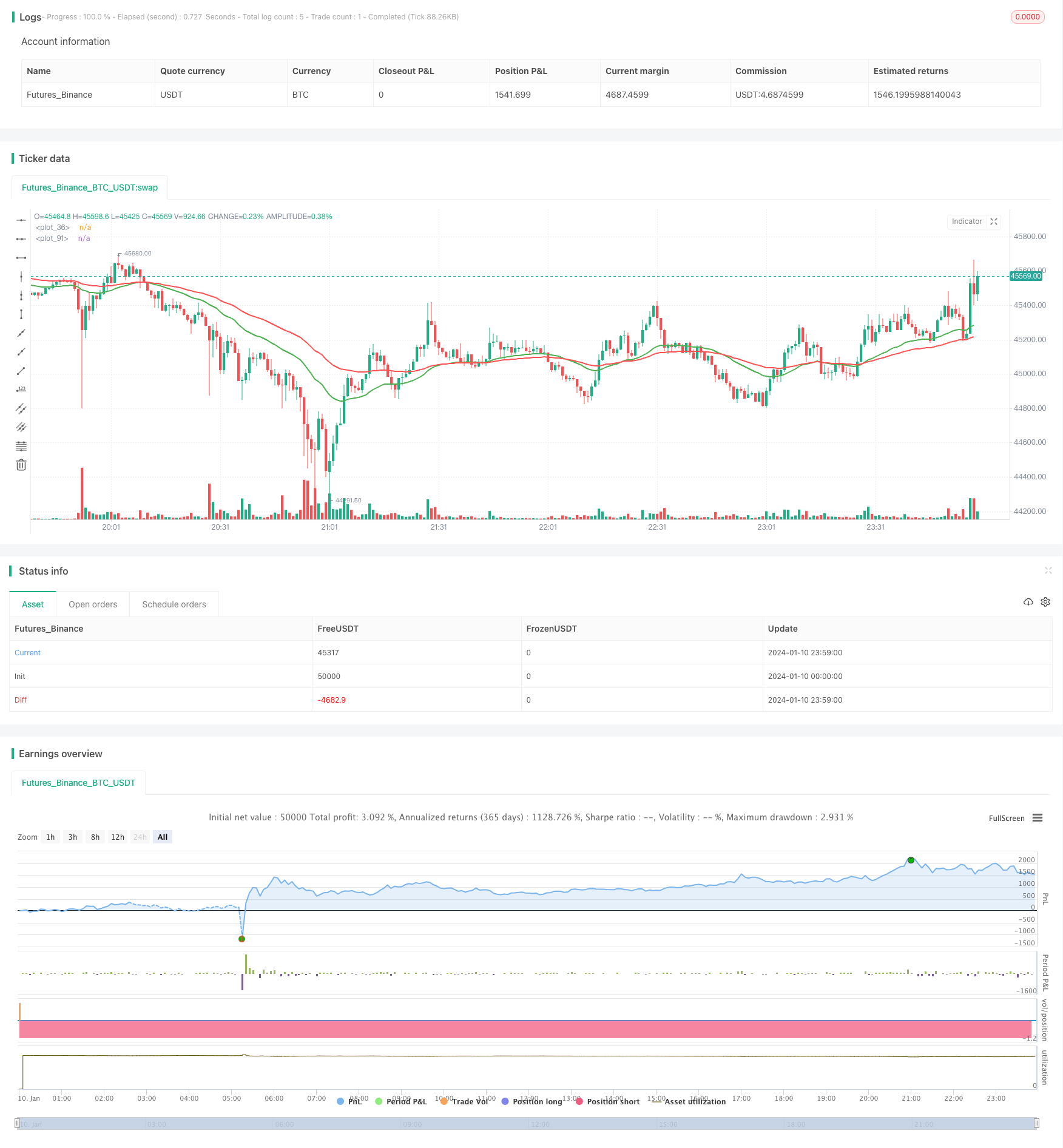Типичная стратегия следования за трендом

Обзор
Двухлинейная перекрестная стратегия - это типичная стратегия для отслеживания тенденций. Она использует среднюю линию EMA на двух разных периодах, делая больше, когда она пересекает среднюю линию длинного периода на коротком периоде, и делая пустоту, когда она пересекает среднюю линию длинного периода на коротком периоде, чтобы захватить поворотные точки ценовой тенденции.
Стратегический принцип
Ключевыми показателями стратегии являются две средние линии EMA, 30 и 60 циклов соответственно. В коде вычисляются две средние линии EMA с помощью специальной функции:
emaLen1 = emaFuncOne(close, lenMA1)
emaLen2 = emaFuncTwo(close, lenMA2)
Торговые сигналы для стратегии исходят из пересечения двух средних линий EMA:
currentState = if emaLen2 > emaLen1
0
else
1
previousState = if emaLastLen2 > emaLastLen1
0
else
1
convergence = if currentState != previousState
1
else
0
Когда кратковременная ЭМА накладывается на долгосрочную ЭМА, currentState не равен предыдущему, появляется перекрестный сигнал. Когда кратковременная ЭМА проходит длительную ЭМА, то текущее состояние не равно предыдущему состоянию и появляется перекрестный сигнал.
Анализ преимуществ
Эта стратегия имеет следующие преимущества:
- Стратегическая концепция проста, интуитивно понятна и легко реализуема
- Эффективное фильтрация рынка шума с использованием гладких свойств EMA
- Автоматическое отслеживание трендов, чтобы не пропустить покупку или продажу
Анализ рисков
Однако эта стратегия также несет в себе некоторые риски:
- Двухлинейный перекрестный сигнал может задерживаться и не успеть вовремя поймать повороты.
- В результате землетрясения может возникнуть несколько ошибочных сигналов.
- Неправильная настройка параметров может привести к слишком чувствительной или слишком задержке
Можно оптимизировать с помощью корректировки цикла EMA или добавления фильтрующих условий.
Направление оптимизации
Эта стратегия может быть оптимизирована в следующих аспектах:
- Тестирование комбинации циклов EMA различной длины
- Фильтрация ложных сигналов при условии увеличения оборота или колебания
- В сочетании с другими индикаторами подтверждение тенденции, например MACD
- Оптимизация управления капиталом, установка стоп-стоп
Подвести итог
Двухлинейная перекрестная стратегия в целом является простой и практичной стратегией отслеживания тенденций. Она прямо-вперед, легко реализуется и может автоматически отслеживать тенденции. Но также существует риск некоторых задержек и ложных сигналов.
/*backtest
start: 2024-01-10 00:00:00
end: 2024-01-11 00:00:00
period: 1m
basePeriod: 1m
exchanges: [{"eid":"Futures_Binance","currency":"BTC_USDT"}]
*/
//@version=2
strategy("ParkerMAStrat", overlay=true)
lenMA1=input(title="Length 1", defval=30)
lenMA2=input(title="Length 2", defval=60)
x = 0
checkLines(current, last) =>
if current > last
x = 1
else
x = 0
x
//plot ema based on len1
emaFuncOne(src, time_period) =>
alpha = 2 / (time_period + 1)
// we have defined the alpha function above
ema = 0.0
// this is the initial declaration of ema, since we dont know the first ema we will declare it to 0.0 [as a decimal]
ema := alpha * src + (1 - alpha) * nz(ema[1])
// this returns the computed ema at the current time
// notice the use of : (colon) symbol before =, it symbolises, that we are changing the value of ema,
// since the ema was previously declared to 0
// this is called mutable variale declaration in pine script
ema
// return ema from the function
emaLen1 = emaFuncOne(close, lenMA1)
plot(emaLen1, color=green, transp=0, linewidth=2)
// now we plot the _10_period_ema
//plot ema based on len2
emaFuncTwo(src, time_period) =>
alpha = 2 / (time_period + 1)
// we have defined the alpha function above
ema = 0.0
// this is the initial declaration of ema, since we dont know the first ema we will declare it to 0.0 [as a decimal]
ema := alpha * src + (1 - alpha) * nz(ema[1])
// this returns the computed ema at the current time
// notice the use of : (colon) symbol before =, it symbolises, that we are changing the value of ema,
// since the ema was previously declared to 0
// this is called mutable variale declaration in pine script
ema
// return ema from the function
//plot ema based on len2
emaFuncOneLast(src, time_period) =>
alpha = 2 / (time_period + 1)
// we have defined the alpha function above
ema = 0.0
// this is the initial declaration of ema, since we dont know the first ema we will declare it to 0.0 [as a decimal]
ema := alpha * src + (1 - alpha) * nz(ema[0])
// this returns the computed ema at the current time
// notice the use of : (colon) symbol before =, it symbolises, that we are changing the value of ema,
// since the ema was previously declared to 0
// this is called mutable variale declaration in pine script
ema
// return ema from the function
//plot ema based on len2
emaFuncTwoLast(src, time_period) =>
alpha = 2 / (time_period + 1)
// we have defined the alpha function above
ema = 0.0
// this is the initial declaration of ema, since we dont know the first ema we will declare it to 0.0 [as a decimal]
ema := alpha * src + (1 - alpha) * nz(ema[0])
// this returns the computed ema at the current time
// notice the use of : (colon) symbol before =, it symbolises, that we are changing the value of ema,
// since the ema was previously declared to 0
// this is called mutable variale declaration in pine script
ema
// return ema from the function
emaLastLen1 = emaFuncOneLast(close, lenMA1)
emaLastLen2 = emaFuncTwoLast(close, lenMA2)
emaLen2 = emaFuncTwo(close, lenMA2)
plot(emaLen2, color=red, transp=30, linewidth=2)
// now we plot the _10_period_ema
//now we compare the two and when green crosses red we buy/sell (line1 vs line2)
previousState = if emaLastLen2 > emaLastLen1
0
else
1
currentState = if emaLen2 > emaLen1
0
else
1
convergence = if currentState != previousState
1
else
0
lineCheck = if convergence == 1
checkLines(currentState, previousState)
if lineCheck == 1
strategy.entry("Long", strategy.long)
else
strategy.entry("Short", strategy.short)